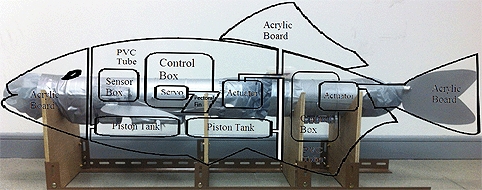NUS claim the robotic fish can be programmed to perform specific submarine functions for marine archaeologists, oil and gas operators, underwater cable companies, and armed services.
The team, comprising Prof Xu Jianxin, Mr Fan Lupeng, graduating electrical engineering student and research fellow, and Dr Ren Qinyuan, will have their research featured at the IEEE/RSJ International Conference on Intelligent Robots and Systems in Tokyo on 3-7 November 2013.
‘Currently, robot fish capable of 2D movements are common, meaning that these models are not able to dive into the water,’ Prof Xu said in a statement. ‘Our model is capable of 3D movements as it can dive and float, using its fins like a real fish. Compared to traditional AUVs [autonomous underwater vehicles], they are certainly more mobile, with greater manoeuvrability. If used for military purpose, fish robots would definitely be more difficult to detect by the enemy.”
According to NUS, robot fish are also quieter and consume less energy compared to traditional AUVs.
‘We chose to study carps because most fish swim like them,’ said Fan, who studied the movements of real carp for three months in order to develop the robot. ‘There is no literature at all on designing a mathematical model on the locomotion of fish and so we had to start from scratch. We used a camera to capture all the possible movements of a carp and then converted the data mathematically so that we could transfer the locomotion of real carp to our robot using different actuators.’
This has proven to be challenging as fish use a lot of different muscles to move, and many actuators are required to enable the robot to move in the same manner.
‘Some fish can achieve almost 180 degree turning in a small turning radius through bending their body while traditional underwater vehicles have a much larger turning radius,’ said Dr Ren. ‘Hence it is quite a feat for us to achieve this movement in our robot fish.’
Other challenges included waterproofing the fish body, the motor and the control box. The fins and tail also need to be flexible so the team chose 1mm acrylic board for these.
Buoyancy and balance for the robot is maintained by using plastic foam attached to both sides. For the diving mechanism, the robot fish is equipped with an internal ballast system to change density. The system is sophisticated enough to enable the fish to dive suddenly to a precise depth.
The team has constructed two fish robots: the larger prototype is approximately 1.5m in length, weighs about 10kg and it can dive to a depth of 1.8m. The smaller robot is about 60cm long and weighs 1.5kg. It has been developed for the investigation of 2D motion control and motion planning in a small place, and it can only swim at water surface.
‘To my knowledge, the world’s smallest fish robot is one about 12.7cm in length. It was designed by MIT for specific military purpose and could go to a depth of 1.5m,’ said Dr Ren.
Underwater vehicles have long gone past the days of the submarines, said Fan. Fish robots, besides being a micro submarine, can also be fully autonomous and can be programmed to perform difficult or dangerous tasks.
The team hopes to make their robot fish even smaller and more realistic.
Fan said, ‘We intend to equip it with more sensors like GPS and video camera to improve autonomous 3D movement. We also intend to test out our fish with more challenging tasks such as object detection.’






Nanogenerator consumes CO2 to generate electricity
Whoopee, they've solved how to keep a light on but not a lot else.